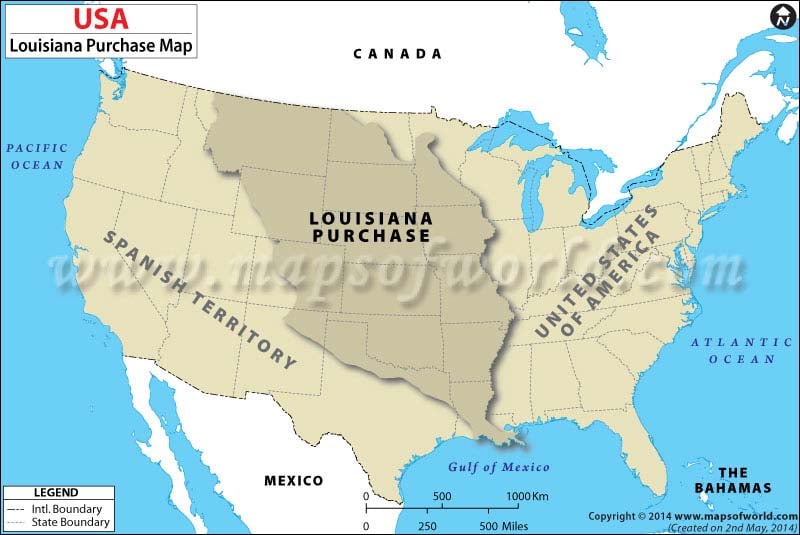Who previously owned the territory of the Louisiana Purchase?
Immediately prior to the Louisiana Purchase, the land in question was secretly sold to France by Spain, who held the European claim to it at the time. Spain was in a weakened position globally, and was under significant pressure from Napoleon. However, upon acquiring the land, Napoleon quickly came to see it as a burden after he began losing his Caribbean territories. He needed quick cash to fuel his military conflicts, and offered the United States a surprisingly generous deal on the land. All these changes in ownership took place over a relatively short period, between the years of 1800 and 1803.
What were the reasons for the Louisiana Purchase ?
Upon discovering that Spain had sold the Louisiana territory to France, U.S. President Thomas Jefferson decided to send representatives to negotiate for the acquisition of the city of New Orleans, a crucial port on the mouth of the Mississippi River. The U.S. was mostly interested only in the city, as well as securing a better foothold in the trade that flourished up and down the river between native tribes and European settlers. The inclusion of a great deal more land in the bargain did not come up until later.
How much did the Louisiana Purchase cost ?
The United States representatives that were sent to negotiate had been authorized by President Jefferson to pay up to 10 million dollars to acquire New Orleans. They were quite surprised when Napoleon’s representative offered them the entire Louisiana territory for only 15 million dollars, and took the deal straight away. It was one of the most lucrative land deals in all of history, and effectively doubled the size of the United States overnight. Much later, after the size of the Louisiana territory had been accurately evaluated, it was discovered that the United States had paid a ludicrously low price of about three cents to the acre.
Whose idea was the Louisiana Purchase ?
Even though it was quite a momentous event, the Louisiana Purchase took place in an environment of chaos, and was nearly so hasty as to be spontaneous. Spain had only given it up in the first place because its colonial power was waning quickly, while Napoleon had scarcely acquired the land before he tried looking for ways to unload it, as he had neither the time nor the resources to control such a vast territory. He instructed his Treasury Minister to sell the whole of it to the United States, whose surprised representatives accepted the offer on the spot. President Thomas Jefferson actually had a difficult time explaining the sudden acquisition to the American people.
Was the Louisiana Purchase a legal sale ?
The Louisiana Purchase was a very controversial move. Many Americans objected, saying that it was a huge overreach of federal power. President Jefferson himself, a proponent of more limited government, was worried that it would make him look hypocritical. There was also concern over the fact that the acquisition had suddenly created thousands of new American citizens, creating the potential for fresh clashes over property, slavery, and cultural differences. Finally, there were grounds to question the legality of the sale: Napoleon had sold it without the consent of the rest of the French government, and selling it in the first place violated several of his treaties with Spain. In the end, despite the objections of the Spanish government and dissatisfied Americans, the acquisition was smoothed over and eventually normalized. Most historians agree that the Louisiana Purchase was technically illegal, although today many Americans look back on it as a triumph.
How big was the Louisiana Purchase ?
It is now known that the size of the Louisiana Purchase was about 2,147,000 square kilometers of land, or about 829,000 square miles, nearly a quarter of the country’s present land mass. At the time that the deal was made, nobody actually had a clear understanding of just how big the Louisiana territory was. Even after the Louisiana Purchase was concluded, there were numerous disputes between the U.S. and Spain as to the boundaries of the territory, especially since they had not been clearly laid out in any of the previous treaties between Spain and France during which the land had changed hands. Ultimately, the question wasn’t settled until 1819, as part of the Adams-Onís Treaty.
What was the Adams-Onís Treaty ?
As colonial Spain was waning in power, it and the United States started having more frequent border disputes. The two governments continually argued and fought over the boundaries of the Louisiana and Missouri territories and the ownership of present-day Florida, but the Adams-Onís Treaty was a turning point that created some more permanent border arrangements. The treaty used many of the discoveries of explorers such as Lewis and Clark, who were originally dispatched to survey the Louisiana Purchase, as parameters for determining the new boundaries of the territory. It transferred ownership of Florida from Spain to the United States, and established the latter’s claim to land stretching all the way past the Rocky Mountains and to the Pacific Coast. In exchange, the U.S. ceded control over the parts of Texas that it had claimed under the Louisiana Purchase, but still got to keep the bulk of its acquisitions.

